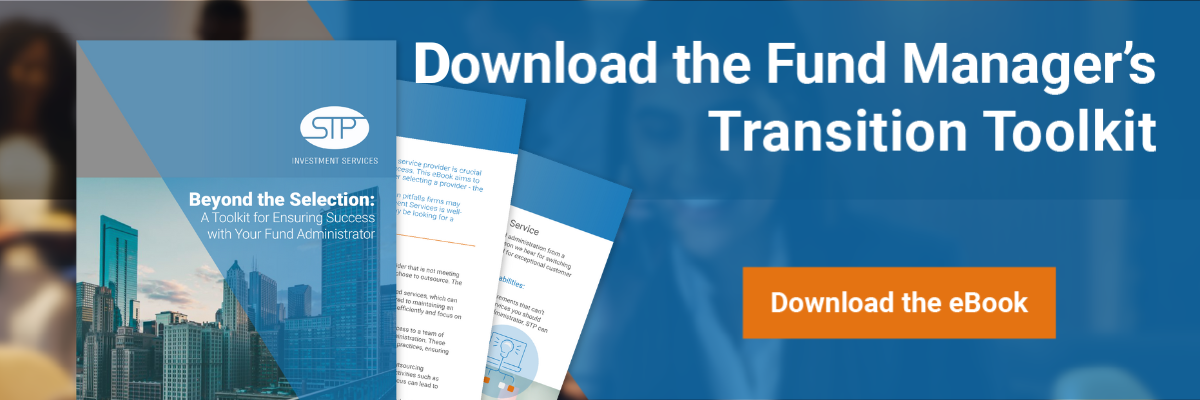5 Common Challenges in Fund Administration Outsourcing and How to Overcome Them

Outsourcing fund administration can be a strategic move for investment management firms, offering numerous benefits such as cost savings and access to specialized expertise. However, it’s not without its challenges. Understanding and addressing these challenges is crucial to maximize the benefits of outsourcing. Here, we explore the common pitfalls firms may encounter and provide practical solutions to overcome them.
1.) Loss of Control over Processes
A frequent concern when outsourcing fund administration is the perceived loss of control over operations. This can stem from inadequate transparency and communication from the service provider, leading to frustration and inefficiencies.
To overcome this challenge, it’s essential to establish clear communication channels and regular reporting mechanisms with your provider. Set expectations for transparency and ensure you have access to real-time data and updates on your fund’s status. By fostering an open and collaborative relationship, you can maintain a sense of control and stay informed about your operations.

2.) Inadequate Resources and Support
Some fund administration providers may lack the necessary resources and support to meet your specific needs. This can result in delayed responses, errors, and overall subpar service quality, which can negatively impact your firm’s performance.
To address this issue, thoroughly vet potential providers before entering into an agreement. Assess their capacity to handle your requirements, including their technological capabilities, staffing levels, and industry expertise. Choosing a provider with a proven track record and robust support infrastructure ensures they can deliver the high-quality service your firm demands.
3.) Cultural and Communication Differences
Differences in organizational culture and communication styles between your firm and the service provider can hinder effective collaboration. Misunderstandings and misaligned expectations can arise, impacting the partnership’s success.
To mitigate this challenge, prioritize cultural alignment and effective communication during the selection process. Look for providers that share similar values and operational philosophies. Additionally, establish clear communication protocols and regular check-ins to ensure both parties are aligned and working towards common goals. Training sessions and team-building activities can also help bridge cultural gaps and foster a collaborative environment.

4.) Lack of Customization and Flexibility
Generic, one-size-fits-all solutions offered by some providers may not address your unique requirements. This lack of customization and flexibility can limit your ability to optimize processes and achieve desired outcomes.
To overcome this, seek out providers that offer tailored solutions and demonstrate a willingness to customize their services to fit your specific needs. During the selection process, discuss your unique requirements and assess the provider’s ability to adapt their offerings accordingly. A provider that prioritizes customization will help you achieve greater efficiency and effectiveness in your fund administration.
5.) Hidden Costs and Inefficiencies
Unexpected fees and inefficiencies can undermine the cost-saving benefits of outsourcing. Hidden costs can arise from various sources, including unclear contract terms, additional service charges, or inefficiencies in the provider’s processes.
To address this issue, thoroughly review and negotiate contract terms before finalizing the agreement. Ensure that all costs are transparent and clearly defined. It’s also advisable to request detailed service level agreements (SLAs) that outline performance expectations and penalties for non-compliance. Regularly monitor the provider’s performance and conduct periodic reviews to identify and rectify any inefficiencies that may arise.
Conclusion
While outsourcing fund administration offers significant advantages, it’s crucial to be aware of the potential challenges and proactively address them. By implementing the strategies outlined above, you can ensure a successful outsourcing experience that enhances your firm’s efficiency and effectiveness.
Understanding and addressing these common challenges will help you build a strong partnership with your service provider, ensuring that your fund administration functions are handled with precision and expertise. By maintaining control, ensuring adequate resources and support, fostering cultural alignment, prioritizing customization, and being vigilant about costs, you can maximize the benefits of outsourcing and focus on delivering exceptional investment strategies and client service.
Outsourcing fund administration is a strategic decision that, when managed correctly, can drive your firm’s growth and success. By taking a proactive approach to these challenges, you can create a seamless and efficient operation that supports your long-term goals.
For a more detailed discussion of the outsourcing option, download our complimentary eBook, Beyond the Selection: A Toolkit For Ensuring Success With Your Fund Administrator.





